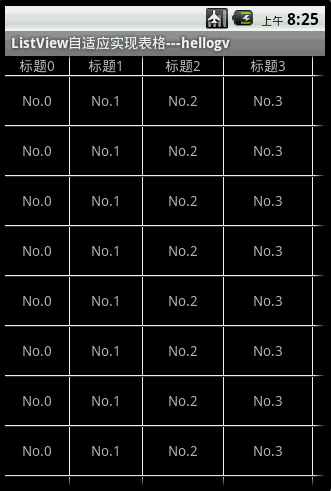ListView自適應(yīng)實(shí)現(xiàn)表格
本文來自http://blog.csdn.net/hellogv/ ,引用必須注明出處!
上次介紹了使用GridView實(shí)現(xiàn)表格,這次就說說如何用ListView實(shí)現(xiàn)自適應(yīng)的表格。GridView比ListView更容易實(shí)現(xiàn)自適應(yīng)的表格,但是GridView每個(gè)格單元的大小固定,而ListView實(shí)現(xiàn)的表格可以自定義每個(gè)格單元的大小,但因此實(shí)現(xiàn)自適應(yīng)表格也會(huì)復(fù)雜些(格單元大小不一)。另外,GridView實(shí)現(xiàn)的表格可以定位在具體某個(gè)格單元,而ListView實(shí)現(xiàn)的表格則只能定位在表格行。因此還是那句老話:根據(jù)具體的使用環(huán)境而選擇GridView 或者 ListView實(shí)現(xiàn)表格。
先貼出本文程序運(yùn)行的效果圖:

本文實(shí)現(xiàn)的ListView表格,可以每個(gè)格單元大小不一,文本(TextView)或圖片(ImageView)做格單元的數(shù)據(jù),不需要預(yù)先定義XML實(shí)現(xiàn)樣式(自適應(yīng)的根本目標(biāo))。由于ListView置于HorizontalScrollView中,因此對(duì)于列比較多/列數(shù)據(jù)比較長(zhǎng)的數(shù)據(jù)表也能很好地適應(yīng)其寬度。
main.xml源碼如下:
 View Code
View Code
<?xml version="1.0" encoding="utf-8"?> <LinearLayout xmlns:android="http://schemas.android.com/apk/res/android" android:orientation="vertical" android:layout_width="fill_parent" android:layout_height="fill_parent"> <HorizontalScrollView android:id="@+id/HorizontalScrollView01" android:layout_height="fill_parent" android:layout_width="fill_parent"> <ListView android:id="@+id/ListView01" android:layout_height="wrap_content" android:layout_width="wrap_content"></ListView> </HorizontalScrollView> </LinearLayout>
主類testMyListView.java的源碼如下:
 View Code
View Code
package com.testMyListView; import java.util.ArrayList; import com.testMyListView.TableAdapter.TableCell; import com.testMyListView.TableAdapter.TableRow; import android.app.Activity; import android.os.Bundle; import android.view.View; import android.widget.AdapterView; import android.widget.ListView; import android.widget.LinearLayout.LayoutParams; import android.widget.Toast; /** * @author hellogv */ public class testMyListView extends Activity { /** Called when the activity is first created. */ ListView lv; @Override public void onCreate(Bundle savedInstanceState) { super.onCreate(savedInstanceState); setContentView(R.layout.main); this.setTitle("ListView自適應(yīng)實(shí)現(xiàn)表格---hellogv"); lv = (ListView) this.findViewById(R.id.ListView01); ArrayList<TableRow> table = new ArrayList<TableRow>(); TableCell[] titles = new TableCell[5];// 每行5個(gè)單元 int width = this.getWindowManager().getDefaultDisplay().getWidth()/titles.length; // 定義標(biāo)題 for (int i = 0; i < titles.length; i++) { titles[i] = new TableCell("標(biāo)題" + String.valueOf(i), width + 8 * i, LayoutParams.FILL_PARENT, TableCell.STRING); } table.add(new TableRow(titles)); // 每行的數(shù)據(jù) TableCell[] cells = new TableCell[5];// 每行5個(gè)單元 for (int i = 0; i < cells.length - 1; i++) { cells[i] = new TableCell("No." + String.valueOf(i), titles[i].width, LayoutParams.FILL_PARENT, TableCell.STRING); } cells[cells.length - 1] = new TableCell(R.drawable.icon, titles[cells.length - 1].width, LayoutParams.WRAP_CONTENT, TableCell.IMAGE); // 把表格的行添加到表格 for (int i = 0; i < 12; i++) table.add(new TableRow(cells)); TableAdapter tableAdapter = new TableAdapter(this, table); lv.setAdapter(tableAdapter); lv.setOnItemClickListener(new ItemClickEvent()); } class ItemClickEvent implements AdapterView.OnItemClickListener { @Override public void onItemClick(AdapterView<?> arg0, View arg1, int arg2, long arg3) { Toast.makeText(testMyListView.this, "選中第"+String.valueOf(arg2)+"行", 500).show(); } } }
ListView自適應(yīng)實(shí)現(xiàn)Table的類TableAdapter.java代碼如下:
PS:TableCell是格單元的類,TableRow是表格行的類,TableRowView是實(shí)現(xiàn)表格行的組件。實(shí)現(xiàn)步驟:TableCell --> TableRow(TableRowView)-->ListView
 View Code
View Code
package com.testMyListView; import java.util.List; import android.content.Context; import android.graphics.Color; import android.view.Gravity; import android.view.View; import android.view.ViewGroup; import android.widget.BaseAdapter; import android.widget.ImageView; import android.widget.LinearLayout; import android.widget.TextView; public class TableAdapter extends BaseAdapter { private Context context; private List<TableRow> table; public TableAdapter(Context context, List<TableRow> table) { this.context = context; this.table = table; } @Override public int getCount() { return table.size(); } @Override public long getItemId(int position) { return position; } public TableRow getItem(int position) { return table.get(position); } public View getView(int position, View convertView, ViewGroup parent) { TableRow tableRow = table.get(position); return new TableRowView(this.context, tableRow); } /** * TableRowView 實(shí)現(xiàn)表格行的樣式 * @author hellogv */ class TableRowView extends LinearLayout { public TableRowView(Context context, TableRow tableRow) { super(context); this.setOrientation(LinearLayout.HORIZONTAL); for (int i = 0; i < tableRow.getSize(); i++) {//逐個(gè)格單元添加到行 TableCell tableCell = tableRow.getCellValue(i); LinearLayout.LayoutParams layoutParams = new LinearLayout.LayoutParams( tableCell.width, tableCell.height);//按照格單元指定的大小設(shè)置空間 layoutParams.setMargins(0, 0, 1, 1);//預(yù)留空隙制造邊框 if (tableCell.type == TableCell.STRING) {//如果格單元是文本內(nèi)容 TextView textCell = new TextView(context); textCell.setLines(1); textCell.setGravity(Gravity.CENTER); textCell.setBackgroundColor(Color.BLACK);//背景黑色 textCell.setText(String.valueOf(tableCell.value)); addView(textCell, layoutParams); } else if (tableCell.type == TableCell.IMAGE) {//如果格單元是圖像內(nèi)容 ImageView imgCell = new ImageView(context); imgCell.setBackgroundColor(Color.BLACK);//背景黑色 imgCell.setImageResource((Integer) tableCell.value); addView(imgCell, layoutParams); } } this.setBackgroundColor(Color.WHITE);//背景白色,利用空隙來實(shí)現(xiàn)邊框 } } /** * TableRow 實(shí)現(xiàn)表格的行 * @author hellogv */ static public class TableRow { private TableCell[] cell; public TableRow(TableCell[] cell) { this.cell = cell; } public int getSize() { return cell.length; } public TableCell getCellValue(int index) { if (index >= cell.length) return null; return cell[index]; } } /** * TableCell 實(shí)現(xiàn)表格的格單元 * @author hellogv */ static public class TableCell { static public final int STRING = 0; static public final int IMAGE = 1; public Object value; public int width; public int height; private int type; public TableCell(Object value, int width, int height, int type) { this.value = value; this.width = width; this.height = height; this.type = type; } } }




 浙公網(wǎng)安備 33010602011771號(hào)
浙公網(wǎng)安備 33010602011771號(hào)